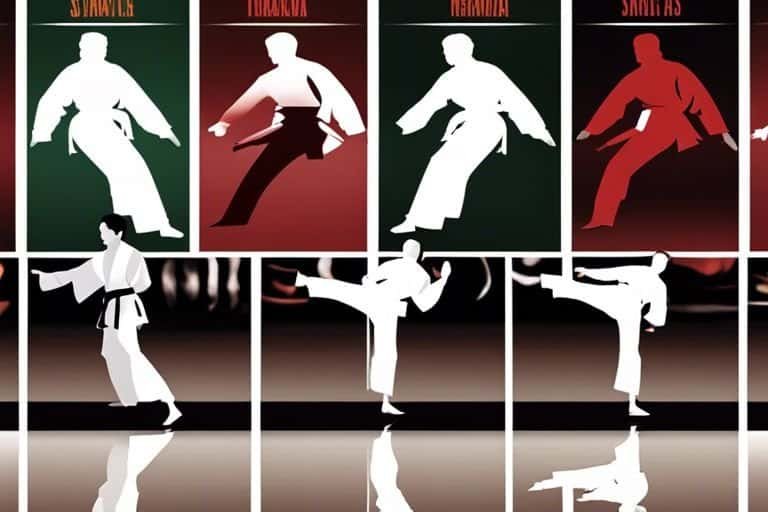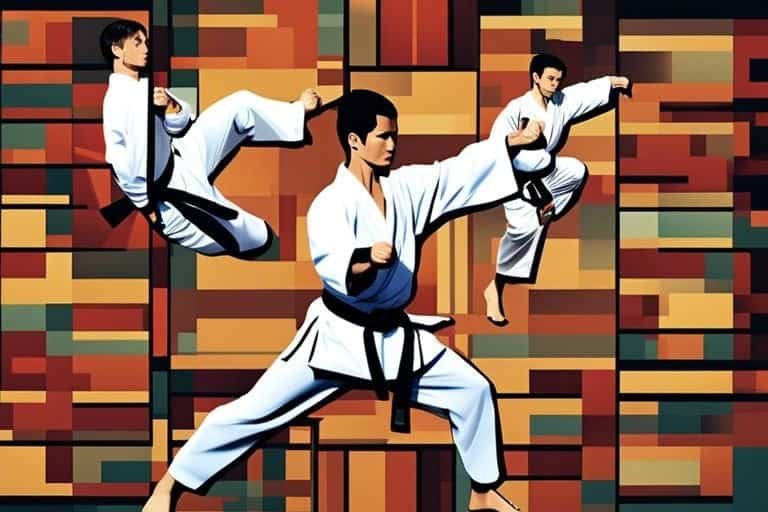Martial arts have a rich history and are practiced by people all over the world. Each discipline offers unique techniques and styles that cater to different individuals. From the graceful flowing movements of Tai Chi to the explosive striking and grappling of Muay Thai, the diversity of martial arts is vast. Understanding the differences in technique and style is crucial for individuals looking to embark on a martial arts journey. This article will delve into the key characteristics of various martial arts, exploring their distinct techniques and styles as well as the practical applications and physical demands of each discipline. By gaining insight into the unique attributes of different martial arts, readers can make an informed decision about which style resonates with their goals and preferences.
Key Takeaways:
- Each martial art has its own unique techniques and style that differentiate it from others, such as the precise strikes in karate versus the joint locks and throws of Brazilian Jiu-Jitsu.
- The emphasis on various aspects of combat can vary greatly among different martial arts, with some focusing more on striking (e.g. Muay Thai) while others prioritise grappling and ground fighting (e.g. Judo).
- Cultural and historical influences play a significant role in shaping the technique and style of each martial art, resulting in diverse approaches to training and combat strategies.
Historical Background and Evolution
Martial arts have a rich historical background that spans centuries and continents, with each discipline having its own unique evolution. Understanding the origins and development of different martial arts can shed light on their distinct techniques and styles, as well as the cultural influences that have shaped them over time.
Origins of Martial Arts
The origins of martial arts can be traced back to ancient civilisations such as China, India, and Japan, where combat techniques were developed for self-defence and warfare. These early forms of martial arts were influenced by the philosophical and spiritual beliefs of their respective cultures, leading to the creation of iconic fighting styles such as Kung Fu, Karate, and Muay Thai. As these disciplines spread across Asia and eventually the world, they underwent further refinement and adaptation, giving rise to the diverse range of martial arts practised today.
Development Across Cultures
The development of martial arts across different cultures has been a fascinating process, resulting in the formation of distinct regional styles and techniques. For example, while Japanese martial arts emphasise discipline and respect, Brazilian martial arts such as Capoeira incorporate fluid movements and acrobatics. The influence of globalisation has also led to the cross-pollination of martial arts, with practitioners integrating elements from various disciplines to create hybrid fighting styles that are effective in both self-defence and combat sports.
Understanding the historical background and evolution of martial arts is crucial for appreciating the diversity and complexity of these disciplines, as well as for identifying the key techniques and styles that define each martial art. By delving into their origins and development across cultures, we can gain a deeper insight into the principles and philosophies that underpin different martial arts, ultimately enhancing our appreciation and understanding of their significance in today’s world.

Comparison of Techniques
When comparing different martial arts styles, it’s essential to look at the differences in techniques and styles. Understanding the unique elements of each discipline can help practitioners appreciate the intricacies and effectiveness of various martial arts. For more insights on the differences in martial arts styles, you can also refer to What are the differences in martial arts styles?
| Striking Techniques | Grappling Techniques |
| Emphasis on powerful kicks and punches | Focus on throws, joint locks, and submission holds |
| Found in disciplines like Muay Thai, Karate, and Taekwondo | Utilised in Judo, Brazilian Jiu-Jitsu, and Sambo |
Striking Techniques Across Styles
Striking techniques vary significantly across different martial arts styles. For example, disciplines like Muay Thai are known for their powerful elbow and knee strikes, while Karate emphasises quick and precise punches. Taekwondo, on the other hand, focuses on dynamic and high-kicking techniques, showcasing the diversity in striking methods.
Understanding the distinctions in striking techniques allows martial artists to broaden their knowledge and adopt effective strategies tailored to their chosen style.
Grappling and Ground Fighting
Grappling is a key component in many martial arts, and ground fighting techniques play a crucial role in various disciplines. Judo emphasises throws and takedowns, while Brazilian Jiu-Jitsu is renowned for its proficiency in submission holds and positional control on the ground. Sambo incorporates a blend of judo and wrestling techniques, providing a well-rounded approach to grappling.
Understanding the nuances of grappling and ground fighting is essential for practitioners, as it enhances their ability to defend against opponents and manipulate positions to gain a strategic advantage.
When delving into the world of grappling and ground fighting, it’s vital to grasp the fundamental principles and refine the techniques to achieve mastery in these areas of combat.
Philosophical and Spiritual Dimensions
When it comes to martial arts, the techniques and styles are not the only considerations. The philosophical and spiritual dimensions of different martial arts also play a crucial role in understanding their essence. These dimensions shape the practitioners’ mindset, discipline, and approach towards both combat and life. If you’re interested in delving deeper into this aspect, you can read more about it in Comparing Styles And Techniques.
Eastern Martial Arts
Eastern martial arts, such as Karate, Kung Fu, and Aikido, are deeply rooted in philosophical and spiritual traditions. These arts emphasise the cultivation of inner strength, discipline, and mental focus. Practitioners are encouraged to seek harmony and balance within themselves and with their surroundings. The meditative and spiritual aspects of these arts are equally as important as the physical techniques, allowing students to develop a holistic approach to self-defence and personal growth.
Furthermore, the philosophy of Eastern martial arts often centres around concepts such as the interconnectedness of all things, striving for self-improvement, and showing respect for opponents and mentors. These arts are not only about learning to defend oneself physically but also about cultivating a harmonious and virtuous way of life.
Western Martial Arts
While Eastern martial arts focus on internal balance and spiritual growth, Western martial arts, such as Boxing and Krav Maga, are more rooted in practicality and efficiency. These arts originated from the need for combat and self-defence in a less philosophical context. However, they still embody important philosophical principles such as discipline, respect, and perseverance.
What sets Western martial arts apart is their practical and straightforward approach to combat. They focus on quick, powerful strikes and efficient defensive manoeuvres, making them highly effective in real-life confrontations. The philosophy of these arts revolves around adapting to any situation, being adaptable, and unlocking one’s physical potential.
For more detailed insights into the philosophical and spiritual dimensions of Western martial arts, visit Comparing Styles And Techniques.
Practical Applications and Contemporary Relevance
When it comes to comparing different martial arts in terms of technique and style, it’s important to consider their practical applications and contemporary relevance. Aikido, for example, offers a unique approach to self-defence and personal safety. If you’re interested in delving deeper into this topic, I recommend checking out Comparing Aikido and Other Martial Arts.
Self-Defense and Personal Safety
One of the key aspects that sets Aikido apart from other martial arts is its non-violent approach to self-defence. Aikido techniques focus on redirecting an opponent’s energy rather than meeting force with force, making it an effective form of self-defence for individuals of all sizes and strengths. This emphasis on harmony and resolution has practical applications in real-life situations, empowering individuals to protect themselves without causing harm to others.
Furthermore, the principles of Aikido have contemporary relevance in promoting conflict resolution and mediation in various settings, from interpersonal disputes to international conflicts. By cultivating a mindset of balance and awareness, Aikido contributes to the broader goal of fostering peace and harmony in society.
Martial Arts in Sports and Entertainment
Aside from self-defence and personal safety, martial arts play a significant role in the realm of sports and entertainment. Martial arts disciplines, such as karate, judo, and taekwondo, have gained popularity as competitive sports and captivating forms of entertainment. Their high-energy performances and dynamic techniques have captivated audiences around the world, showcasing the skill and athleticism of practitioners.
Moreover, martial arts have crossed over into mainstream media and popular culture, with feature films and television shows often portraying martial arts as a powerful and visually compelling art form. This widespread representation further highlights the enduring appeal of martial arts in contemporary society.

Conclusion: Comparing Martial Arts Techniques and Styles
In conclusion, the comparison of different martial arts techniques and styles reveals a wide array of approaches to combat and self-defence. Each martial art has its own unique techniques, principles, and philosophies, reflecting the diverse cultural and historical backgrounds from which they originate. While some martial arts may focus on striking and powerful kicks, others may prioritise grappling and ground fighting. It is important to recognise that the effectiveness of a martial art is not solely determined by the techniques and styles it employs, but also by the skill and adaptability of the practitioner. Ultimately, the choice of martial art comes down to personal preference, fitness goals, and the individual’s inclination towards a particular style of combat. Regardless of the differences, the fundamental goal of all martial arts remains the same – to cultivate discipline, physical fitness, and mental fortitude.
FAQ
Q: How do different martial arts compare in terms of technique and style?
A: The comparison of different martial arts in terms of technique and style can vary greatly depending on the specific martial art being compared. Factors such as origins, foundational principles, striking and grappling techniques, and overall philosophy contribute to the distinctiveness of each martial art. Let’s explore this further through the following frequently asked questions:
Q: Which martial arts focus on striking techniques?
A: Martial arts such as Muay Thai, Boxing, and Taekwondo are known for their emphasis on striking techniques. These arts often utilise punches, kicks, elbows, and knees as primary forms of attack, each with its own unique principles and strategies.
Q: What are some martial arts that focus on grappling and ground fighting?
A: Arts such as Brazilian Jiu-Jitsu, Judo, and Sambo are renowned for their focus on grappling and ground fighting techniques. These arts emphasise the ability to control and submit opponents on the ground through joint locks, chokes, and positional dominance.
Q: How do traditional martial arts, such as Karate and Kung Fu, compare to more modern combat sports like MMA?
A: Traditional martial arts often prioritise discipline, form, and mental focus, while modern combat sports like MMA (Mixed Martial Arts) integrate techniques from various disciplines, including striking, grappling, and ground fighting. MMA is characterised by its adaptability and effectiveness in real-life combat situations.
Q: What are the stylistic differences between Japanese martial arts and Chinese martial arts?
A: Japanese martial arts, such as Aikido and Judo, often emphasise harmony, redirection of an opponent’s energy, and efficient use of body movements. On the other hand, Chinese martial arts, such as Wing Chun and Tai Chi, focus on fluidity, balance, and the cultivation of internal energy (chi) through structured forms and techniques.
Q: How do the philosophies of martial arts influence their respective techniques and styles?
A: The philosophical underpinnings of martial arts greatly influence their techniques and styles. For example, arts like Krav Maga prioritise practical self-defence and efficiency, while arts like Capoeira integrate aspects of dance and acrobatics into their fighting techniques, reflecting cultural and historical influences.



